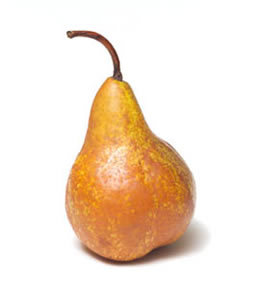Bosc Pears: Taste, Nutritional Benefits, and Storage Tips
- By The FruitGuys
- Reading Time: 3 mins.

Bosc pears are a distinguished pear variety—some might even say gentlemanly! They’re celebrated for their unique, elongated shape and rough, cinnamon-brown skin. Native to Europe, they can trace their roots back to the early 1800s in Belgium or France. They’re named after M. Bosc, a former director of the Paris Botanical Garden.
What Is a Bosc Pear?
The Bosc pear is a European pear, but it thrives in the temperate climate and fertile soil of California and the Pacific Northwest. Look for Boscs in the fall, when they’re flavorful and fresh from the orchard. Curious about their unusual texture? It comes from natural russetting. Russetted pears are safe to eat and can actually have a unique, nutty flavor.
Taste Profile of Bosc Pears
Bosc pears are versatile in the break room and the kitchen. We’re fans of their dense, firm flesh, which holds up well in baking, poaching, and cooking. They’re also delicious out of hand thanks to their sweet, subtly spiced flavor and buttery texture. Boscs sweeten up earlier in the ripening process than other pears, so you can eat them when they’re still firm.
Nutritional Insights for Bosc Pears
Here’s a detailed look at the nutritional profile for a medium-sized Bosc pear. Grab one next time you’re looking for a healthy snack.
Hydrating and Low-Calorie
Bosc pears are super hydrating and diet-friendly, with about 149 grams of water and 120 calories per pear.
High in Natural Sugar, Carbs, and Fiber
A medium Bosc pear has about 28.8 grams of carbohydrates thanks to natural sugars and gut-healthy dietary fiber. The fiber (more than 5 grams per fruit) can help with digestion and regulating your blood sugar.
Rich in Minerals
Bosc pears offer 218 mg of potassium, 17.9 mg of calcium, and 0.269 mg of iron per fruit. They also supply magnesium, phosphorus, zinc, copper, manganese, and a trace of selenium, which help with all kinds of things from bone health to immune defense.
Packed with Vitamins
Bosc pears are notable for their vitamin content, with 5.01 mg of Vitamin C and small amounts of folate, Vitamin K, thiamin, riboflavin, niacin, pantothenic acid, and Vitamin B-6, which play roles in energy metabolism and overall cellular health.
Low in Fat
Bosc pears are basically fat-free, so they’re a great choice for a heart-healthy snack.
How to Ripen and Store Bosc Pears
Keep Bosc pears at room temperature until they’re ripe and ready to eat. To check if it’s time to take a bite, try this simple method.
Check Ripeness With the Stem Test
- Gently press near the stem of the pear.
- If the pear yields slightly under pressure, it is ripe and ready to eat.
Bonus Storage Tips
- Once your Bosc pears are ripe, transfer them from the counter to the refrigerator. This slows down the ripening process and can keep them at the right stage to snack on for up to five more days.
- Avoid placing Bosc pears near strong-smelling foods like blue cheese or fish. Pears can absorb odors, which can actually change their flavor!
FAQs
1. How can you tell when a Bosc pear is ripe?
To check if a Bosc pear is ripe, press gently near the neck of the pear with your finger. If it yields slightly, it’s ready to eat. You might also notice a slight wrinkling at the base of the stem.
2. Can Bosc pears be eaten with the skin on?
Absolutely! The skin of the Bosc pear is full of fiber and nutrients. Its texture is a nice contrast to the tender flesh of the pear, though it’s perfectly fine to pare away the skin if you prefer.
3. What makes Bosc pears different from other pears?
Bosc pears have a uniquely firm texture, making them ideal for cooking as they hold their shape well. Their complex, sweet-but-spiced flavor profile also sets them apart. Try one to see for yourself!
Want farm-fresh fruit?
We've got you covered.Recent Articles
Subscribe to our Newsletter
"*" indicates required fields





